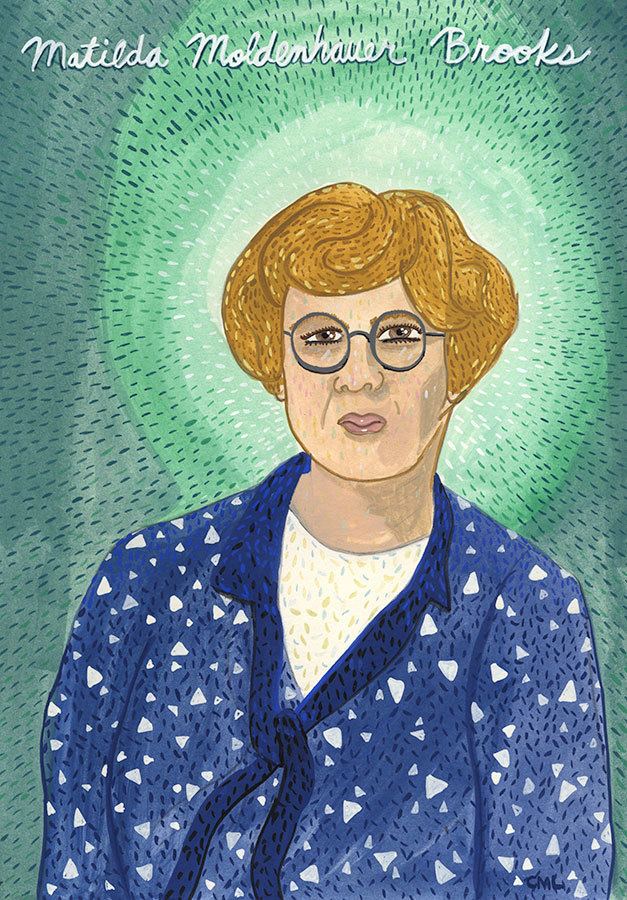Nationality American | Name Matilda Brooks Spouse Sumner Cushing Brooks | |
 | ||
Thesis Quantitative studies on the respiration of Bacillus subtilis (Ehrenberg) Cohn (1920) Died 1981, San Francisco, California, United States | ||
Matilda Moldenhauer Brooks (1888–1981) is best remembered for her 1932 discovery that the staining compound methylene blue is an antidote to carbon monoxide and cyanide poisoning.
Contents
- Education
- United States Public Health Service
- University of California Berkeley
- Matilda M Brooks v Commissioner of Internal Revenue
- Activism
- Personal life
- Selected works
- References

Education
Brooks earned her BS and MS at the University of Pittsburgh, where she was a member of Kappa Alpha Theta, and her PhD from Harvard University in 1920.
United States Public Health Service
Brooks conducted joint research projects with her husband, biologist Sumner Cushing Brooks. They worked together for the United States Public Health Service from 1920 to 1927.
University of California, Berkeley
In 1927, Sumner Brooks was offered a faculty position in Zoology at the University of California, Berkeley, to teach physicochemical biology, becoming the first person at Berkeley to teach classroom and lab courses in experimental cell biology. Thereafter Matilda M. Brooks was described as being on the research staff at Berkeley, where she continued publishing her own papers and collaborating with her husband for 20 years.
Matilda M. Brooks v. Commissioner of Internal Revenue
Brooks' true status at Berkeley emerges from a decision by the Ninth Circuit, U.S. Court of Appeals in a 1959 federal income tax case. In Matilda M. Brooks, Petitioner, v. Commissioner of Internal Revenue, Respondent, we learn that when Sumner Brooks died in 1948, Matilda was left with a lab and some small grants but no salary. When her husband had taken up his faculty post, she had been barred from a paying job by Berkeley’s anti-nepotism policy and allowed only a non-paying appointment. With her husband’s death, Berkeley offered Matilda a stipend of $500 a year. Drawing on personal savings and investments plus small research grants, Matilda M. Brooks continued her career. In 1952 and 1953, she made two scientific trips to Europe, claiming expenses of $2,988 and $3,685, respectively. This was too much for the IRS, which denied the exemptions. Brooks lost in Tax Court but insisted on appealing. And she won.
Brooks argued that even though she couldn’t hope to earn a living from publishing scientific papers alone, she would profit professionally from European travel by gathering materials and conferring with peers to preserve her academic reputation. "It is difficult in view of mankind’s almost universal drive for monetary reward alone to recognize that petitioner was required to spend many thousands of dollars to retain the position paying her but $500 per annum," wrote Justice Stanley M. Barnes. But that was the case here, the court ruled, reversing in favor of Brooks.
Activism
In 1933, Brooks published a rejoinder in JAMA after a previous paper by a male physician reported successful treatments of cyanide poisoning with methylene blue omitted the fact that Brooks had published her discovery the year before.
In June 1936, Brooks wrote to the Board of Trustees of Mount Holyoke College. "May I add my voice of protest to that of the others against the appointment of a man as head of Mt. Holyoke College? The education of women has progressed a long way from the time when they were allowed to sit out of sight behind curtains to listen to the words of wisdom which proceeded from the mouths of men instructors... It seems to me that in this modern age when there are so many able women in this country, educated and trained for leadership among not only women, but also men, that it is a very curious reactionary decision on the part of those in power, to revert to the age-old custom of considering a man as the only one able to head a group of women."
Personal life
Brooks met her husband, Sumner Cushing Brooks, in 1916 in Cambridge, MA, where she was working on her PhD in zoology and he'd just finished his in botany.
